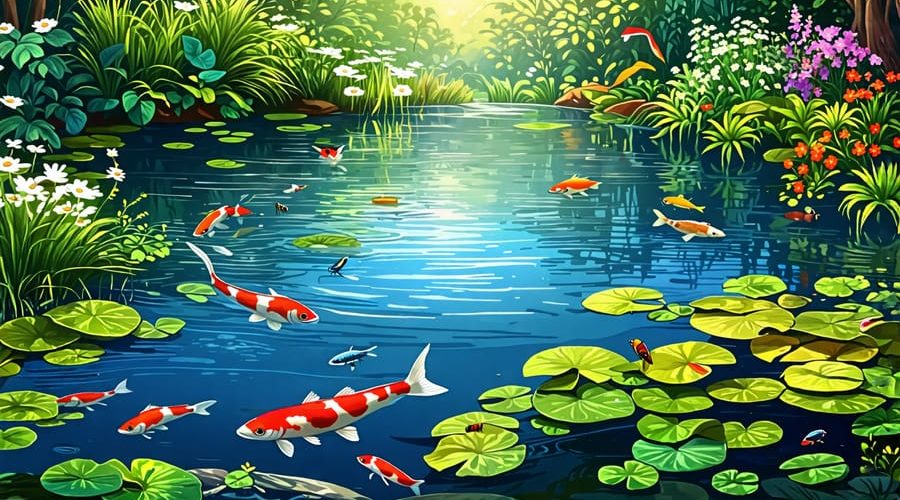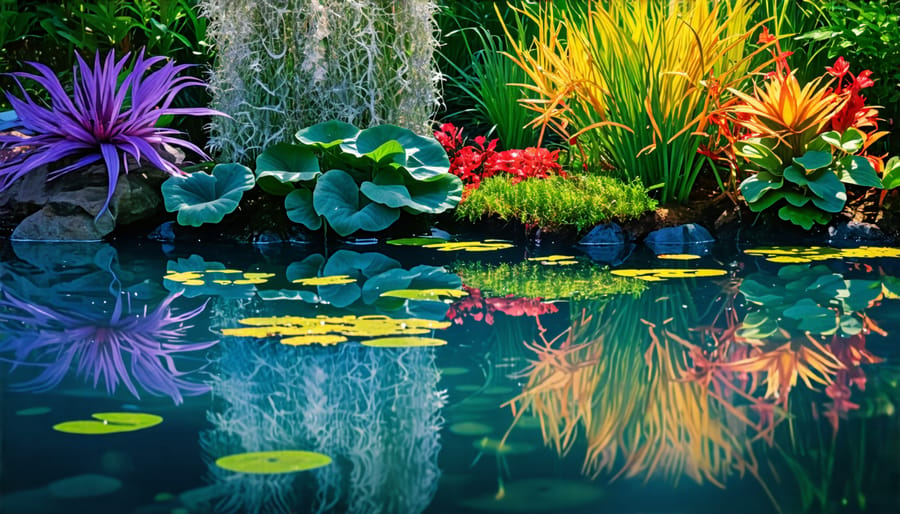
7 Simple Steps to Measure the Biodiversity in Your Pond or Water Garden
Biodiversity is the incredible variety of life on Earth, from towering trees to microscopic microbes. But how do scientists measure this staggering diversity of species in ecosystems around the world? Quantifying biodiversity is essential for understanding the health of our planet and identifying areas in need of protection. By counting the number of species, analyzing genetic variation, and calculating ratios like species evenness and richness, researchers can put hard numbers to nature’s complexity. This data-driven approach reveals critical insights about the state of global biodiversity – and what we must do to preserve it before it’s too late. In an era of accelerating extinctions and human impact, the quest to quantify the diversity of life has never been more vital.
Step 1: Identify Plant Species
Identifying the various aquatic plant species in your pond is the first crucial step in quantifying its biodiversity. Start by carefully observing each distinct plant and noting its unique characteristics, such as leaf shape, color, texture, and growth pattern. Take clear photos of the plants from different angles to aid in identification later.
Consult reliable resources like aquatic plant guidebooks, online databases, or local experts to match your observations with known aquatic plant species. Pay attention to subtle differences between similar-looking plants to ensure accurate categorization.
When you’ve identified each species, create a list and tally the number of individuals or clusters of each type. For smaller plants or those that grow in dense mats, you may need to estimate the coverage area instead of counting individual specimens.
If you encounter any unfamiliar species, consider collecting a small sample for further examination, but be sure to follow any local regulations and avoid disturbing the ecosystem. With patience and a keen eye, you’ll soon have a comprehensive inventory of the plant life that makes your pond unique and vibrant.

Step 2: Count Fish and Amphibians
To estimate fish and amphibian populations in your pond, the method will vary based on the size of the water feature. For smaller ponds, you can often get an accurate count just by careful observation. Take a seat near the edge of the pond and watch patiently for 15-30 minutes. Look for telltale signs like ripples on the surface, movement under lily pads, or the occasional splash. Keep a tally of each species you spot.
For medium to large ponds, a more systematic approach is needed. Try the “transect” method – mentally divide the pond into sections and count the fish/amphibians in each section separately. Use landmarks like rocks or plants to delineate the sections. Extrapolate the average per section to get a total estimate.
Alternatively, set up underwater cameras or traps overnight to capture footage of nocturnal species you might miss during the day. Frog call surveys on spring/summer nights can also help identify species present.
Remember, the goal is a reasonable population estimate, not an exact census. With practice, you’ll develop an intuitive sense of the biodiversity in your backyard oasis. The thrill of discovery never gets old, whether it’s spotting tadpoles or realizing your pond supports a rare newt species. So get out there and start counting!
Step 3: Survey Insect Life
Insects are a vital part of any pond ecosystem, and quantifying their presence is a key step in assessing biodiversity. To survey insect life, start by carefully observing the water’s surface and margins. Look for water striders gracefully skating across the pond and whirligig beetles spinning in mesmerizing patterns. Peer into the shallows for the darting movements of backswimmers and water boatmen.
Next, examine vegetation in and around the pond. Gently turn over leaves to reveal hidden treasures like colorful leafhopper nymphs and tiny aphids. Keep an eye out for busy ants tending to their aphid “livestock” and ladybugs patrolling for their next meal. Don’t forget to check beneath rocks and logs for scurrying ground beetles and earwigs.
As dusk falls, watch for the aerial acrobatics of dragonflies and damselflies hawking mosquitoes above the water. Listen for the chirps and trills of crickets and katydids adding to the evening symphony. Consider setting up a light trap overnight to attract and count nocturnal insects like moths and midges.
Remember, a diverse and abundant insect community is a sign of a thriving pond. Embrace the creepy-crawlies as essential threads in the vibrant tapestry of your aquatic oasis.
Step 4: Don’t Forget Microorganisms
While you’re quantifying the visible biodiversity in your pond, don’t forget about the microscopic life teeming beneath the surface! Microorganisms like bacteria, protists, and algae play a crucial role in maintaining a healthy, balanced ecosystem. Though you can’t count them individually, there are a couple of ways to gauge their prevalence.
First, take a look at your pond’s water clarity. If it’s consistently murky or green, that’s a sign of an overabundance of algae, which could indicate an imbalance in the microbial community. On the other hand, crystal clear water often means a well-functioning ecosystem with balanced microbial populations.
Next, observe the health of your aquatic plants. Are they vibrant and thriving, or do they look sickly and covered in algae? Healthy plants generally signify a balanced microbial community in the water and soil, while struggling plants may indicate an unhealthy microorganism imbalance. By keeping an eye on these indirect indicators, you can get a rough sense of the unseen biodiversity in your pond.

Step 5: Consider Visiting Critters
When tallying up the biodiversity in your pond, don’t forget about the visitors! Birds, dragonflies, butterflies, and other creatures may not be permanent residents, but they still contribute to the vibrant ecosystem. Take a leisurely seat by the water’s edge and observe who drops by for a drink, a quick dip, or to snack on insects. Jot down the different species you spot and add them to your overall biodiversity count. These transient guests play a vital role in the intricate web of life that makes your pond so special. Embrace the opportunity to witness nature’s diversity in action!
Step 6: Calculate a Biodiversity Score
Now that you’ve tallied up the different species in your pond, it’s time to calculate your very own biodiversity score! Don’t worry, you won’t need a PhD in ecology for this. We’ve come up with a simple formula that anyone can use. First, take the total number of species you counted and multiply it by 10. Then, divide that result by the square footage of your pond’s surface area. Voila! You’ve got your biodiversity score.
For example, let’s say you spotted 12 different species and your pond measures 200 square feet. Your calculation would be: (12 x 10) ÷ 200 = 0.6. A score between 0.5 and 1 indicates a healthy, diverse ecosystem. Under 0.5 suggests there’s room for improvement, while anything over 1 means you’ve got a thriving underwater paradise!
Keep in mind, this is a simplified measure and there’s always more to learn about the intricate web of life beneath the surface. But it’s a fantastic starting point to gauge your pond’s ecological balance. With this score in hand, you can track changes over time and make informed decisions to nurture an even richer tapestry of aquatic life. Happy calculating, pond enthusiasts!
Step 7: Track and Improve Over Time
Monitoring your pond’s biodiversity over time is key to maintaining a thriving ecosystem. Plan to reassess your biodiversity score every few months, especially as seasons change. Keep a log of your scores to track progress and identify trends. If you notice a decline, investigate potential causes like water quality issues, invasive species, or habitat disruption.
Continuously look for ways to enhance biodiversity in your pond. Introduce new native plant species to provide diverse habitats and food sources. Add structural elements like logs, rocks, and shallow areas to accommodate different creatures. Minimize the use of chemicals and opt for natural pond management techniques.
Remember, a biodiverse pond is a resilient and beautiful one. By regularly assessing and nurturing biodiversity, you’ll create a vibrant aquatic oasis that supports a wide array of life. Enjoy the journey of stewardship as you cultivate a thriving ecosystem in your own backyard pond.
